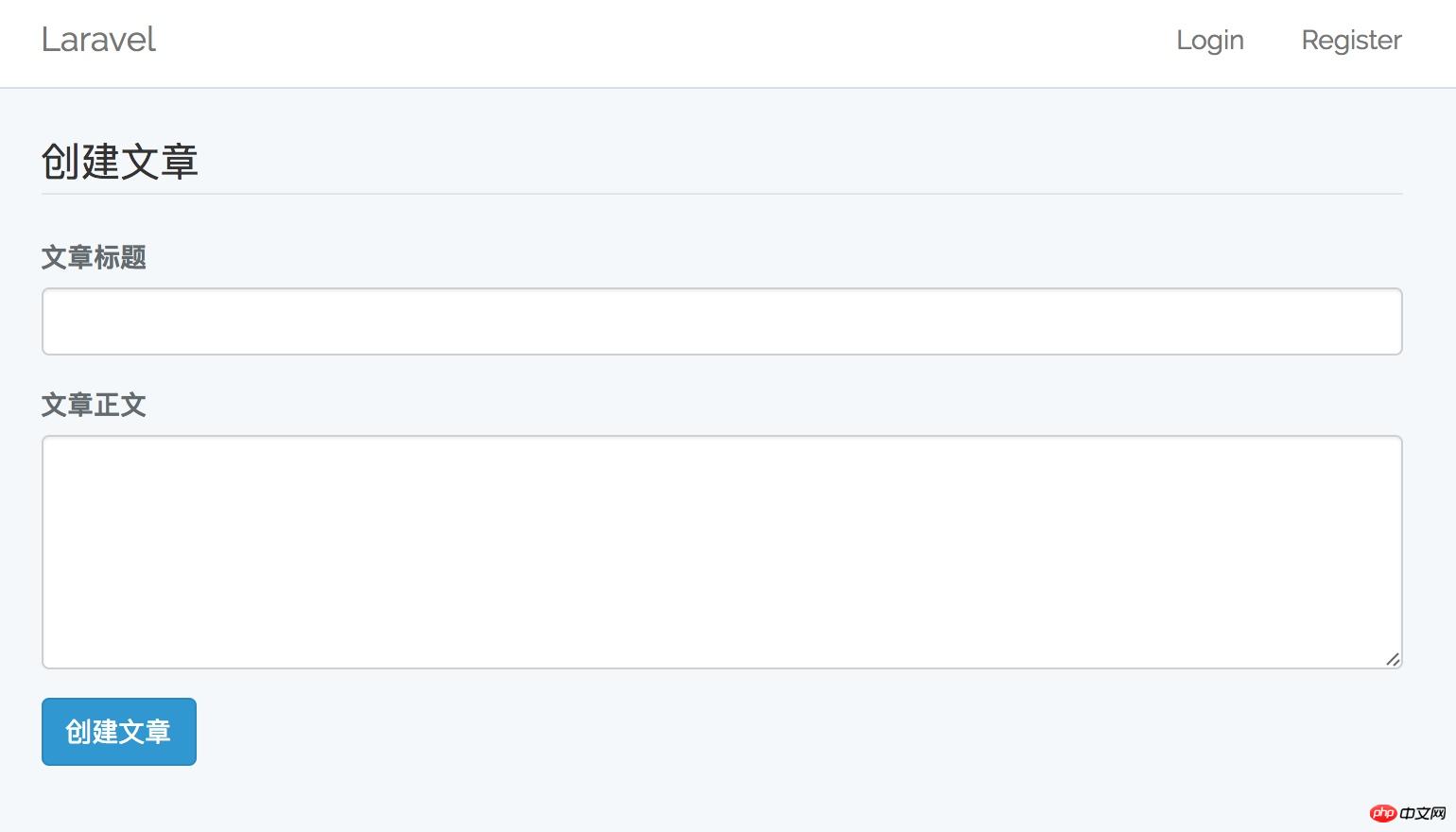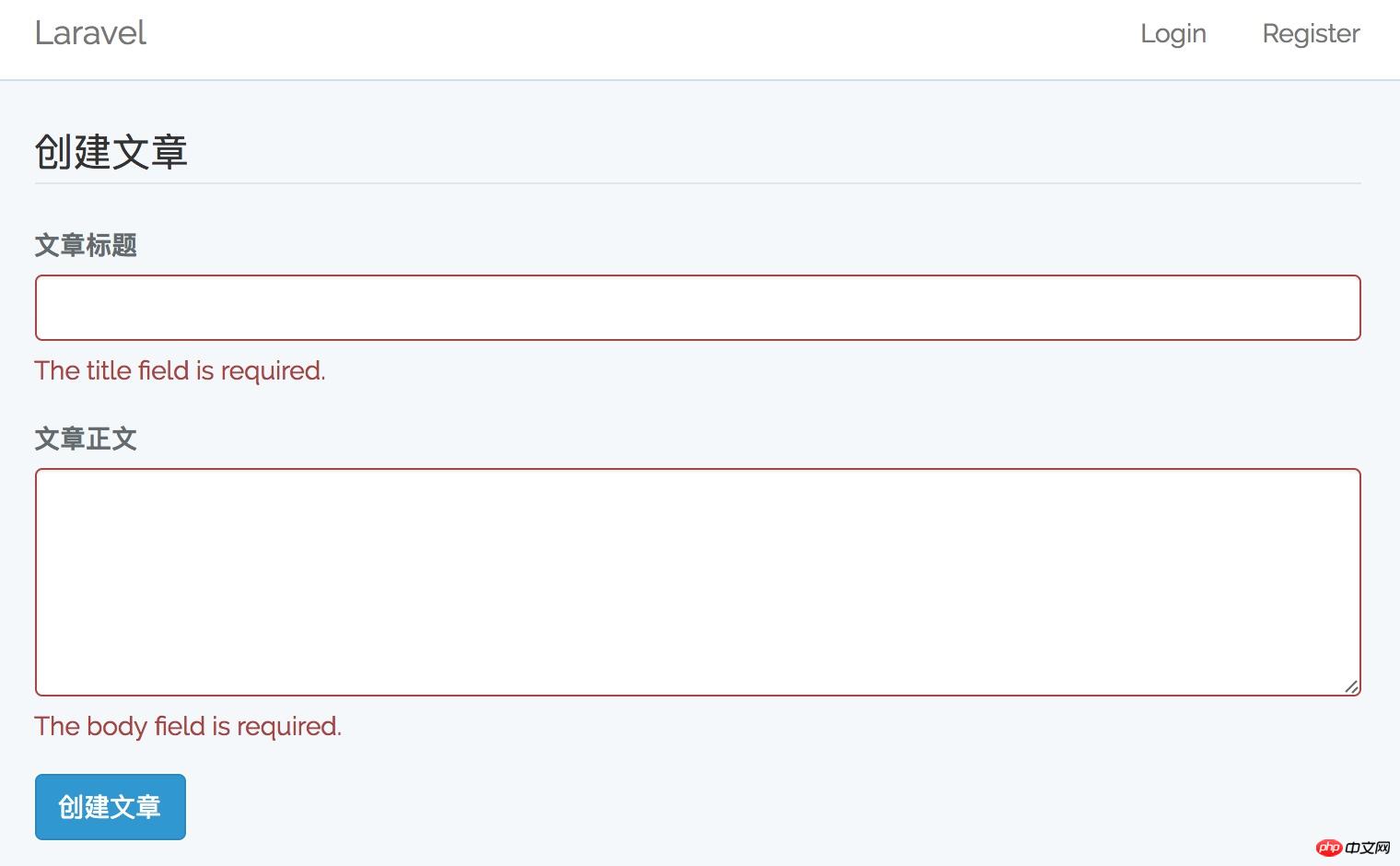 PHP Framework
PHP Framework
 Laravel
Laravel
 Vue.js in laravel5.4 framework implements Ajax form submission error verification
Vue.js in laravel5.4 framework implements Ajax form submission error verification
Vue.js in laravel5.4 framework implements Ajax form submission error verification
Jul 31, 2018 pm 02:00 PMThe content of this article is about the Ajax form submission error verification implemented by vue.js in the laravel5.4 framework. It has certain reference value and I hope it can help friends in need.
Before starting, first prepare the development environment. We assume that you have installed Laravel. As for the introduction of Vue, please refer to the official documentation.
After completing the above preparations, we can start our development. In this tutorial, we will demonstrate the form verification of the article publishing page.
First add two routing rules in routes/web.php:
Route::get('post/create', 'PostController@create'); Route::post('post/save', 'PostController@save');
Then run the Artisan command in the project root directory to create the controller PostController:
php artisan make:controller PostController
In Two new methods are added to the generated controller for processing routing requests:
public function create() {
return view('post.create');
}
public function save(Request $request) {
// 設(shè)置驗證規(guī)則
$this->validate($request, [
'title' => 'required',
'body' => 'required'
]);
}Next, we need to create a response view. In order to reuse the existing style and page layout, we first run the following Artisan command :
php artisan make:auth
In this way we can reuse the authentication function page layout that comes with Laravel, create the view file post/create.blade.php, and edit the file content as follows:
@extends('layouts.app')
@section('content')
<div class="container">
<!--創(chuàng)建成功顯示消息-->
<div class="alert alert-success" v-if="submitted">
創(chuàng)建成功!
</div>
<!--頁面提交之后阻止刷新-->
<form @submit.prevent="createPost" method="POST">
<legend>創(chuàng)建文章</legend>
<!--如果title字段驗證失敗則添加.has-error-->
<div class="form-group" :class="{'has-error':errors.title}">
<label>文章標(biāo)題</label>
<input type="text" name="title" class="form-control" v-model="post.title" value="{{ old('title') }}">
<!--如果驗證失敗通過FormError組件顯示錯誤信息-->
<form-error v-if="errors.title" :errors="errors">
@{{errors.title.join(',')}}
</form-error>
</div>
<!--如果body字段驗證失敗則添加.has-error-->
<div class="form-group" :class="{'has-error':errors.body}">
<label>文章正文</label>
<textarea name="body" class="form-control" rows="5" v-model="post.body">{{ old('body') }}</textarea>
<!--如果驗證失敗通過FormError組件顯示錯誤信息-->
<form-error v-if="errors.body" :errors="errors">
@{{errors.body.join(',')}}
</form-error>
</div>
<button type="submit" class="btn btn-primary">創(chuàng)建文章</button>
</form>
</div>
@endsectionAt this time The access page is empty because we have not defined Vue-related data variables. The layouts.app layout view references app.js, and this js is compiled from resources/assets/js/app.js, so we are going to Define Vue-related code here:
var app = new Vue({
el: '#app',
data: {
post: {
title: '',
body: ''
},
errors: [],
submitted: false
},
methods: {
createPost: function () {
var self = this;
axios.post('/post/save', self.post).then(function(response) {
// form submission successful, reset post data and set submitted to true
self.post = {
title: '',
body: '',
};
// clear previous form errors
self.errors = '';
self.submitted = true;
}).catch(function (error) {
// form submission failed, pass form errors to errors array
self.errors = error.response.data;
});
}
}
});We also saw form-error in the view file, which is actually a sub-component in Vue. We can create this new one in the resources/assets/js/components directory. Component file, a sample Example.vue is provided in this directory, we can refer to this sample to write a new FormError.vue:
<template>
<span class="help-block">
<slot></slot>
</span>
</template>
<script>
export default {
props: ['errors']
}
</script>Here we pass the data errors in the parent component to the child component in to display error messages in child components. After completing the creation of the subcomponent, don't forget to introduce it in the above resources/assets/js/app.js:
Vue.component('form-error', require('./components/FormError.vue'));
In this way, we have completed all the coding work, and then run the following command to recompile js:
npm run dev
Of course, in the development environment, we prefer to use npm run watch. This command will monitor changes in the front-end resource files and then recompile them to avoid manual compilation after each modification.
In this way, when you access the post/create page in the browser, it will be displayed normally:

Fill in nothing, click the create button, and the page will be The error message can be displayed:

After filling in the corresponding fields and then submitting, it will prompt that the creation is successful.
In this way, we have completed a simple Ajax form submission verification function based on Vue in Laravel. Personally, I feel that it has significantly improved development efficiency
Related recommendations:
Laravel’s new features: high-level messaging
The above is the detailed content of Vue.js in laravel5.4 framework implements Ajax form submission error verification. For more information, please follow other related articles on the PHP Chinese website!

Hot AI Tools

Undress AI Tool
Undress images for free

Undresser.AI Undress
AI-powered app for creating realistic nude photos

AI Clothes Remover
Online AI tool for removing clothes from photos.

Clothoff.io
AI clothes remover

Video Face Swap
Swap faces in any video effortlessly with our completely free AI face swap tool!

Hot Article

Hot Tools

Notepad++7.3.1
Easy-to-use and free code editor

SublimeText3 Chinese version
Chinese version, very easy to use

Zend Studio 13.0.1
Powerful PHP integrated development environment

Dreamweaver CS6
Visual web development tools

SublimeText3 Mac version
God-level code editing software (SublimeText3)

Hot Topics
 What are policies in Laravel, and how are they used?
Jun 21, 2025 am 12:21 AM
What are policies in Laravel, and how are they used?
Jun 21, 2025 am 12:21 AM
InLaravel,policiesorganizeauthorizationlogicformodelactions.1.Policiesareclasseswithmethodslikeview,create,update,anddeletethatreturntrueorfalsebasedonuserpermissions.2.Toregisterapolicy,mapthemodeltoitspolicyinthe$policiesarrayofAuthServiceProvider.
 How do I install Laravel on my operating system (Windows, macOS, Linux)?
Jun 19, 2025 am 12:31 AM
How do I install Laravel on my operating system (Windows, macOS, Linux)?
Jun 19, 2025 am 12:31 AM
Yes,youcaninstallLaravelonanyoperatingsystembyfollowingthesesteps:1.InstallPHPandrequiredextensionslikembstring,openssl,andxmlusingtoolslikeXAMPPonWindows,HomebrewonmacOS,oraptonLinux;2.InstallComposer,usinganinstalleronWindowsorterminalcommandsonmac
 What are controllers in Laravel, and what is their purpose?
Jun 20, 2025 am 12:31 AM
What are controllers in Laravel, and what is their purpose?
Jun 20, 2025 am 12:31 AM
The main role of the controller in Laravel is to process HTTP requests and return responses to keep the code neat and maintainable. By concentrating the relevant request logic into a class, the controller makes the routing file simpler, such as putting user profile display, editing and deletion operations in different methods of UserController. The creation of a controller can be implemented through the Artisan command phpartisanmake:controllerUserController, while the resource controller is generated using the --resource option, covering methods for standard CRUD operations. Then you need to bind the controller in the route, such as Route::get('/user/{id
 How do I customize the authentication views and logic in Laravel?
Jun 22, 2025 am 01:01 AM
How do I customize the authentication views and logic in Laravel?
Jun 22, 2025 am 01:01 AM
Laravel allows custom authentication views and logic by overriding the default stub and controller. 1. To customize the authentication view, use the command phpartisanvendor:publish-tag=laravel-auth to copy the default Blade template to the resources/views/auth directory and modify it, such as adding the "Terms of Service" check box. 2. To modify the authentication logic, you need to adjust the methods in RegisterController, LoginController and ResetPasswordController, such as updating the validator() method to verify the added field, or rewriting r
 How do I use Laravel's validation system to validate form data?
Jun 22, 2025 pm 04:09 PM
How do I use Laravel's validation system to validate form data?
Jun 22, 2025 pm 04:09 PM
Laravelprovidesrobusttoolsforvalidatingformdata.1.Basicvalidationcanbedoneusingthevalidate()methodincontrollers,ensuringfieldsmeetcriterialikerequired,maxlength,oruniquevalues.2.Forcomplexscenarios,formrequestsencapsulatevalidationlogicintodedicatedc
 How do I escape HTML output in a Blade template using {{{ ... }}}? (Note: rarely used, prefer {{ ... }})
Jun 23, 2025 pm 07:29 PM
How do I escape HTML output in a Blade template using {{{ ... }}}? (Note: rarely used, prefer {{ ... }})
Jun 23, 2025 pm 07:29 PM
InLaravelBladetemplates,use{{{...}}}todisplayrawHTML.Bladeescapescontentwithin{{...}}usinghtmlspecialchars()topreventXSSattacks.However,triplebracesbypassescaping,renderingHTMLas-is.Thisshouldbeusedsparinglyandonlywithfullytrusteddata.Acceptablecases
 Selecting Specific Columns | Performance Optimization
Jun 27, 2025 pm 05:46 PM
Selecting Specific Columns | Performance Optimization
Jun 27, 2025 pm 05:46 PM
Selectingonlyneededcolumnsimprovesperformancebyreducingresourceusage.1.Fetchingallcolumnsincreasesmemory,network,andprocessingoverhead.2.Unnecessarydataretrievalpreventseffectiveindexuse,raisesdiskI/O,andslowsqueryexecution.3.Tooptimize,identifyrequi
 How do I mock dependencies in Laravel tests?
Jun 22, 2025 am 12:42 AM
How do I mock dependencies in Laravel tests?
Jun 22, 2025 am 12:42 AM
TomockdependencieseffectivelyinLaravel,usedependencyinjectionforservices,shouldReceive()forfacades,andMockeryforcomplexcases.1.Forinjectedservices,use$this->instance()toreplacetherealclasswithamock.2.ForfacadeslikeMailorCache,useshouldReceive()tod





